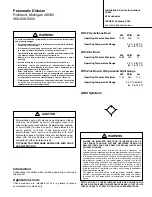
USE AND MAINTENANCE MANUAL - SECTION 8
AERIAL PLATFORM ELEVAH 70 – Rev. 04_2020
Page 8-3
CHECKS ON LIFTING CHAINS
1) Chain noise
A grinding metal noise will be heard if the chains are not fully lubricated. This causes metal-metal
friction between the joints of the chain, which can lead to seizing-slipping effect, causing the work
platform to move unevenly.
2) Surface rust
Plates with rusty surfaces are easily recognisable by the typical brown colour. Rust can lead to chain
fatigue failures.
3) Rust on joints
Corroded connection points are recognisable by their red-brown colour. This phenomenon may arise
from lack of lubrication or use of grease and oil unsuitable for penetrating the joints.
4) Stiff joints
Any joint that is not in a straight position when leaving the return pulley, can no longer be used. This
phenomenon may be caused by corrosion or cold micro welding.
5) Turned pins
This is the consequence of incorrect lubrication and the aforementioned phenomenon of stiffened
joints. This phenomenon is easily recognised by the difference in the pin clinching positions
compared to factory standard.
6) Pins coming out of their housings
A direct consequence of the stiff joints of turned pins.
7) Wear
It is important to assess whether the connection plates are very worn.
8) Broken plates
This is the result of fatigue failure caused by overloading. Corrosion phenomena may contribute to
this problem.
9) Broken pins
This problem usually occurs as a result of corrosion in the chain joints. Since the pins of a single
chain are subject to the same load and corrosion conditions, one failure is usually followed by more.
Experience has shown that this type of failure is not always easily recognised as there are no evident
changes in the chain conditions, especially in the initial stage.
















































